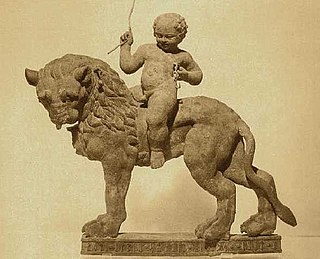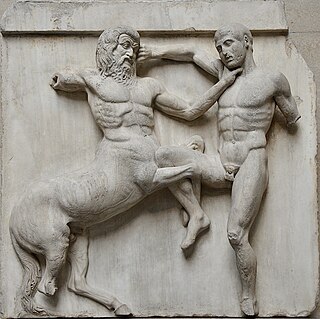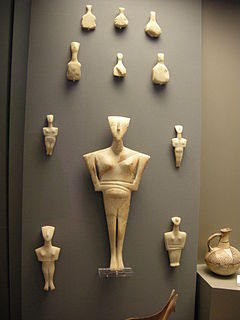 W
WAncient art refers to the many types of a art produced by the advanced cultures of ancient societies with some form of writing, such as those of ancient China, India, Mesopotamia, Persia, Palestine, Egypt, Greece, and Rome. The art of pre-literate societies is normally referred to as Prehistoric art and is not covered here. Although some Pre-Columbian cultures developed writing during the centuries before the arrival of Europeans, on grounds of dating these are covered at Pre-Columbian art, and articles such as Maya art and Aztec art. Olmec art is mentioned below.
 W
WAncient South Arabian art was the art of the Pre-Islamic cultures of South Arabia, which was produced from the 3rd millennium BC until the 7th century AD.
 W
WAntiquities are objects from antiquity, especially the civilizations of the Mediterranean: the Classical antiquity of Greece and Rome, Ancient Egypt and the other Ancient Near Eastern cultures. Artifacts from earlier periods such as the Mesolithic, and other civilizations from Asia and elsewhere may also be covered by the term. The phenomenon of giving a high value to ancient artifacts is found in other cultures, notably China, where Chinese ritual bronzes, three to two thousand years old, have been avidly collected and imitated for centuries, and the Pre-Columbian cultures of Mesoamerica, where in particular the artifacts of the earliest Olmec civilization are found reburied in significant sites of later cultures up to the Spanish Conquest.
 W
WThe ancient Cycladic culture flourished in the islands of the Aegean Sea from c. 3300 to 1100 BCE. Along with the Minoan civilization and Mycenaean Greece, the Cycladic people are counted among the three major Aegean cultures. Cycladic art therefore comprises one of the three main branches of Aegean art.
 W
WDukkan-e Daud, is a late Achaemenid rock site located in the vicinity of Sarpol-e_Zahab, in Kermanshah Province, Iran. The site was discovered by Henri Rawlinson in 1836. It consists of a rock tomb dug several meters high in a rock face overhanging a relief called Kil-e Daud.
 W
WAn engraved gem, frequently referred to as an intaglio, is a small and usually semi-precious gemstone that has been carved, in the Western tradition normally with images or inscriptions only on one face. The engraving of gemstones was a major luxury art form in the Ancient world, and an important one in some later periods.
 W
WHardstone carving is a general term in art history and archaeology for the artistic carving of predominantly semi-precious stones, such as jade, rock crystal, agate, onyx, jasper, serpentinite, or carnelian, and for an object made in this way. Normally the objects are small, and the category overlaps with both jewellery and sculpture. Hardstone carving is sometimes referred to by the Italian term pietre dure; however, pietra dura is the common term used for stone inlay work, which causes some confusion.
 W
WIndo-Greek art is the art of the Indo-Greeks, who reigned from circa 200 BCE in areas of Bactria and the Indian subcontinent. Initially, between 200 and 145 BCE, they remained in control of Bactria while occupying areas of India, until Bactria was lost to invading nomads. After 145 BCE, Indo-Greek kings ruled exclusively in parts of ancient India, especially in Gandhara and the area of Punjab. The Indo-Greeks had a rich Hellenistic heritage and artistic proficiency as seen with the remains of the city of Ai-Khanoum, which was founded as a Greco-Bactrian city. In India, several Indo-Greeks cities are known such as Sirkap near Taxila, or Barikot, where some Indo-Greek artistic remains have been found, such as stone palettes. Some Buddhist cultural objects related to the Indo-Greeks are known, such as the Shinkot casket. But by far the most important Indo-Greek remains in India are the beautiful and numerous coins of the Indo-Greek kings, considered as some of the most artistically brilliant of Antiquity. Most of the works of art of the Greco-Buddhist art of Gandhara are usually attributed to the direct successors of the Indo-Greeks in India in the 1st century CE, such as the nomadic Indo-Scythians, the Indo-Parthians and, in an already decadent state, the Kushans. Many Gandharan works of art cannot be dated exactly, leaving the exact chronology open to interpretation. With the realization that the Indo-Greeks ruled in India until at least 10-20 CE with the reign of Strato II in the Punjab, the possibility of a direct connection between the Indo-Greeks and Greco-Buddhist art has been reaffirmed recently.
 W
WParthian art was Iranian art made during the Parthian Empire from 247 BC to 224 AD, based in the Near East. It has a mixture of Persian and Hellenistic influences. For some time after the period of the Parthian Empire, art in its styles continued for some time. A typical feature of Parthian art is the frontality of the people shown. Even in narrative representations, the actors do not look at the object of their action, but at the viewer. These are features that anticipate the art of medieval Europe and Byzantium.